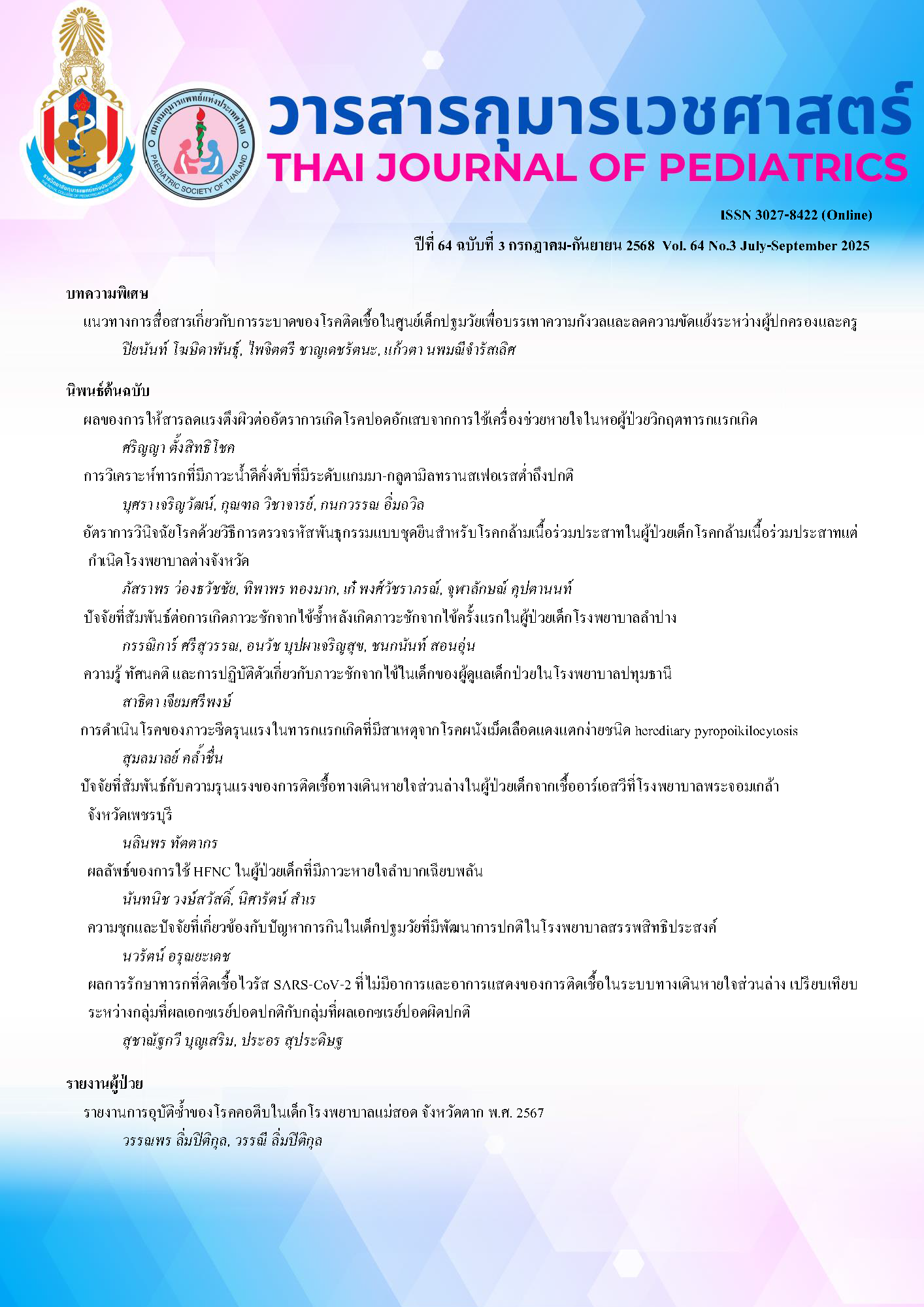Outcome of SARS-CoV-2 infected infants without symptoms and signs of lower respiratory tract infection compared between normal and abnormal chest X-ray groups
Keywords:
Infant, coronavirus disease 2019, COVID-19, SARS-CoV-2, Chest x-ray, radiographAbstract
Background: Currently SARS-CoV-2 infection causes less severe infection, however infants under 1 year old, who are considered as a high-risk group for severe manifestations, are more likely to be hospitalized and receive chest X-ray in most cases.
Objective: To study treatments and outcomes of hospitalized COVID-19 infants with absent symptoms and signs of lower respiratory tract infection (LRTI), comparing between a normal chest X-ray group and an abnormal chest X-ray group, in order to determine the necessity to perform chest X-ray in this population.
Methods: A cross-sectional study was conducted on COVID-19 infants who were hospitalized during March 1, 2022 to June 30, 2023 in QSNICH. Patients with LRTI, underlying conditions with pre-existing abnormal chest X-ray and no x-ray reports via radiologists were excluded. Clinical data, treatment and outcomes were analyzed.
Result: Among 208 patients, there were 96 (46.2%) infants with normal chest x-ray and 112 (53.8%) infants with abnormal chest x-ray. All of them received oral favipiravir as an antiviral agent. None of normal chest x-ray group developed LRTI, meanwhile 4 of 112 patients in abnormal chest x-ray group proceeded to LRTI (0 vs 3.6%, p value 0.47), substituted favipiravir to intravenous remdesivir (0 vs 3.6%, p value 0.27), and 3 of them obtained antibiotics (0 vs 2.6%, p value 0.43). Defervescence times after receiving antiviral agents, duration of upper respiratory tract symptoms and length of hospital stay were not statistically different between two groups {33.2(24,72) vs 36.2(24,72) hrs. (p value 0.076), 2.44 (0.93) vs 2.56 (0.54) days (p value 0.34) and 2.81 (1.03) vs 2.80 (0.95) days (p value 0.23) respectively. All of them made a full recovery.
Conclusion: There was no statistically significant difference in treatments and outcomes in COVID-19 infants, presenting with no clinical manifestations of LRTI, compared between normal and abnormal chest X-rays group. Performing chest X-ray may not be necessary in COVID-19 infants who do not have symptoms and signs of LRTI.
Downloads
References
กรมควบคุมโรค กระทรวงสาธารณสุข. รายงานข่าวกรองโรคติดต่ออุบัติใหม่ เดือนตุลาคม 2565 [อินเทอร์เน็ต]. นนทบุรี: กรมควบคุมโรค; 2565 [เข้าถึงเมื่อ 14 ส.ค. 2568]. เข้าถึงจาก: https://ddc.moph.go.th
Cobar O, Cobar S. Omicron variants world prevalence, 148 WHO weekly epidemiological update and CDC COVID data tracker review as of June 23, 2023 [Preprint]. ResearchGate. 2023 Jun [cited 2024 Jul 30]. Available from: https://www.researchgate.net/publication/371811130
Oterino Serrano C, Alonso E, Andrés M, Buitrago NM, Pérez Vigara A, Parrón Pajares M, et al. Pediatric chest x-ray in COVID-19 infection. Eur J Radiol. 2020;131:109236.
Vendhan K, Kathirrajan M, Kathirvelu G, Balasubramanian S. Chest radiograph findings in children with COVID-19—A retrospective analysis from a tertiary care paediatric hospital in South India. J Trop Pediatr. 2023;69:016.
Sobolewska-Pilarczyk M, Pokorska-Spiewak M, Stachowiak A, Marczynska M, Talarek E, Oldakowska A, et al. COVID-19 infections in infants. Sci Rep. 2022;12:7765.
Dona’ D, Montagnani C, Di Chiara C, Venturini E, Galli L, Lo Vecchio A, et al. COVID-19 in infants less than 3 months: Severe or not severe disease? Viruses. 2022;14:2256.
Bergin N, Moore N, Doyle S, England A, McEntee MF. Radiographic features of COVID-19 in children—A systematic review. Children (Basel). 2022;9:1620.
Downloads
Published
How to Cite
Issue
Section
License
Copyright (c) 2025 The Royal College of Pediatricians Of Thailand

This work is licensed under a Creative Commons Attribution-NonCommercial-NoDerivatives 4.0 International License.



